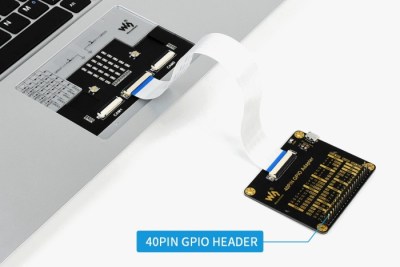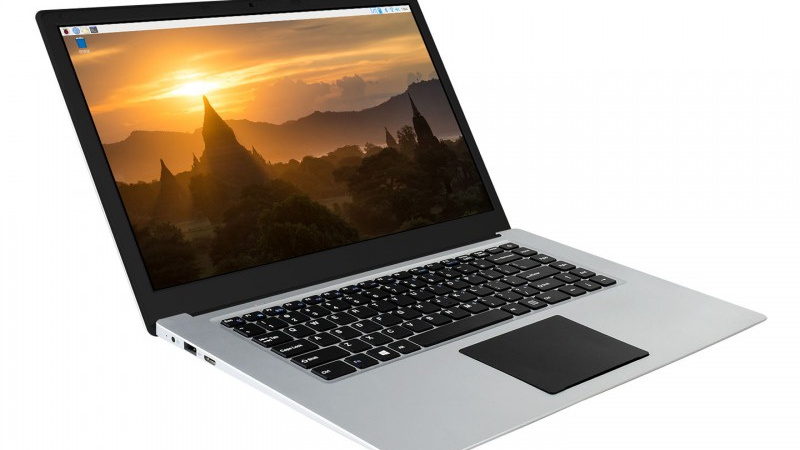The good news it that you can now buy a pretty decent laptop that’s based around the Raspberry Pi Compute Module (CM). The bad news is that it was conceived before anyone knew the interface was going to change for the new CM4, so it doesn’t have any of the features that would make it really interesting such as support for PCI-Express. Oh, and it costs $300.
Waveshare, the company that most of us know best as a purveyor of e-paper displays, also made some rather interesting design choices on their laptop. See that black pad under the keyboard? No, it’s not a trackpad. It’s just a decorative cover that you remove to access an LED matrix and GPIO connectors. Make no mistake, a laptop that features a GPIO breakout right on the front is definitely our jam. But the decision to install it in place of the trackpad, and then cover it with something that looks exactly like a trackpad, is honestly just bizarre. It might not be pretty, but the Pi 400 seemed to have solved this problem well enough without any confusion.
 On the other hand, there seems to be a lot to like about this product. For one, it’s a very sleek machine that doesn’t have the boxy and somewhat juvenile look that seems so common in other commercial Pi laptops. We also like that Waveshare included a proper Ethernet jack, something that’s becoming increasingly rare even on “real” laptops. As [ETA PRIME] points out in the video after the break, the machine also has a crisp IPS display and a surprisingly responsive keyboard. Though the fact that it still has a “Windows” key borders on being offensive considering how much it costs.
On the other hand, there seems to be a lot to like about this product. For one, it’s a very sleek machine that doesn’t have the boxy and somewhat juvenile look that seems so common in other commercial Pi laptops. We also like that Waveshare included a proper Ethernet jack, something that’s becoming increasingly rare even on “real” laptops. As [ETA PRIME] points out in the video after the break, the machine also has a crisp IPS display and a surprisingly responsive keyboard. Though the fact that it still has a “Windows” key borders on being offensive considering how much it costs.
But really, the biggest issue with this laptop is when it finally hit the market. If Waveshare had rushed this out when the CM3 was first introduced, it probably would have been a more impressive technical achievement. On the other hand, had they waited a bit longer they would have been able to design it around the far more capable CM4. As it stands, the product is stuck awkwardly in the middle.
[Thanks to Sathish for the tip.]
















Oh look! It’s the Raspberry Air!
I have to say, it’s a bit disingenuous to make it look like it has a trackpad. I would be pretty sore if I didn’t notice that before buying one of these. A laptop you have to move your hand to the screen in order to click on anything, is not a laptop to me.
I think they’re running into the same problem all of the Pi laptops do: by the time you add everything else you need, it costs as much as a full-featured laptop.
This. Especially when are enough Pi emulators around (including GPIOs)
Oh, I don’t know about that. Maybe not having a touch pad is a good feature or at least not the worst possible bug.
I recently purchased a NexDock Touch. I usually use it with my phone although it can be used with a Pi.
Anyway I love my NexDock but the one complaint I have is that the touch pad is too sensitive. It often registers clicks when I am typing and not even touching the pad. Fortunately there is an option to turn it off so most of the time I end up doing so and just relying on the touch screen or, Samsung Dex can use the phone’s screen as a touchpad.
Probably can make touchpad in form of custom PCB with capacitive pads under the solder mask, that will replace the cover and connect to i2c using that GPIO ribbon connector which is already in place… Some time ago i saw i2c capacitive sensor ICs which does have enough channels to work as basic trackpad. Datasheet even suggested PCB design for trackpad configuration.
Perhaps it’s based on an off-the-shelf laptop shell that already had a touchpad cutout, as I suspect they all do these days, so they had to do something with the gaping hole at the front.
And they couldn’t just put, you know, a touchpad in it.
Regarding the Ethernet jack there’s a solution tom embed one into thin laptops without requiring a (sometimes proprietary) dongle, fujitsu came with this: https://www.youtube.com/watch?v=M7fcJM6iunA&feature=youtu.be&t=121
I know most people here know about them since they’re old but still they’re pretty neat IMHO
I had a PCMCIA Ethernet card that had a jack similar to this. Pretty cool for as thin as PCMCIA cards were.
I had a work laptop (I think it was a Sony Vaio) that had an ethernet port that was kind of rotated. You’d pull the bottom flap down a bit and it would present the port to you. Possibly it was thicker than this demonstration though.
Yes I got a Toshiba ultraportable that did this also, it’s a less fragile/costly middle-ground solution and nice to have indeed !
Remember the X-Jack? Push in and out pops a phone or Ethernet port, into which the cable plugs vertically. Used to make Type II PCMCIA and CardBus modems and network cards without needing a dongle or bulky external end on the card, so it could be left installed full time with nothing to break or get lost.
An old story about this…
Years ago at a computer shop I worked in, we had a Russian woman for a customer. She brought in her Dell laptop, purchased in Scotland with UK Windows 95, over which had been installed Russian Windows 95. (That would eventually become its own sort of ‘fun’.) She also had Russian Microsoft Word, but discs for neither.
It had a US Robotics 28.8K (I said it’s an old story) PCMCIA modem with X-Jack, bought in Scotland along with the laptop. The modem decided it was no longer going to ‘speak American’ and wouldn’t connect to the local dialup service anymore.
So I called up 3-Com/USR in Salt Lake City to find out if it was still under warranty. I got a woman on the line and soon as I said it was a USR modem with X-Jack she went into full on snotty snide condescending you’re an idiot voice, like Fran Drescher in “The Nanny” but with 3x more nasality.
“Sir. X-Jack is a 3-Com exclusive! There is no such thing as a US Robotics modem with X-Jack.”
Nevermind I’m holding the “nonexistent” USR modem with X-Jack in my hand. I waited a few minutes then called back and got a man who sounded American, not an import from the permanently pissed off state of New Jersey. It was a quick and easy thing for him to enter the modem’s serial number, find it was still under warranty and all I’d have to pay was postage to 3-Com/USR in Salt Lake. He did say something about never having seen a USR with X-Jack but apparently was able to access their UK product info to see that it really existed.
Took quite a while to get it back. I called and they didn’t know where it was. I got a call back later saying it had been found. A few more days and it arrived, in a brand new hard case. To this day I assume they most likely sent the modem off to their UK division because it was not a version sold in North America.
Thanks, that helps me a lot.
Laptop that needs a mouse… kind of a joke of a product
Dig out the old Logitech clip on trackball. http://xahlee.info/kbd/logitech_trackman_portable_trackball.html
The touchpad (or lack there of) problem aside, the location of the GPIO + CSI is pretty poor because it blocks the keyboard by forcing you to have your widgets hooked up in front of the laptop. These expansion ports should have been on the side, but it is probably using a COTS laptop frame that wouldn’t have anywhere to put them.
I wonder if the omission of the touchpad was intentional (to have a spot for a GPIO connectors), due to cost, or maybe both. This would be a solid product if they added a touchpad and moved the expansion ports to the side, even if it did increase the cost.
Such a shame because it’s so damn close to being a really cool product!
Those style of ribbon cables are flimsy as hell. Definitely not for repeated removal and insertion.
It’s probably the same shell the PineBook and other laptop/lapdocks are using. They all seem to look very similar, I’m guessing some Chinese factory makes these shells and you can put whatever you want inside.
Would not surprise me to see hinged screen and battery packs that you just snap a Pi 400 into or onto in a couple of months, at $150 ish. So figure these won’t have a long run.
Right. I think all of the people who’ve developed all-in-one portable computers from the Raspberry Pi got blind-sided by both the 400 and the CM4. I was working on a Pi4B laptop myself when these were announced, but looking at both of these, I still found it better overall to just build around the Pi4B, since I need all of the connectors it provides anyway, so no need for the Compute Module, and want to use a smaller (40% or 50%) keyboard, so the 400 is out as well. But I’m still curious to see on the market what you’re talking about – a snap-on that makes the 400 into a laptop. Although I still don’t like the idea of a laptop without a touchpad.